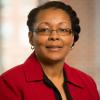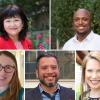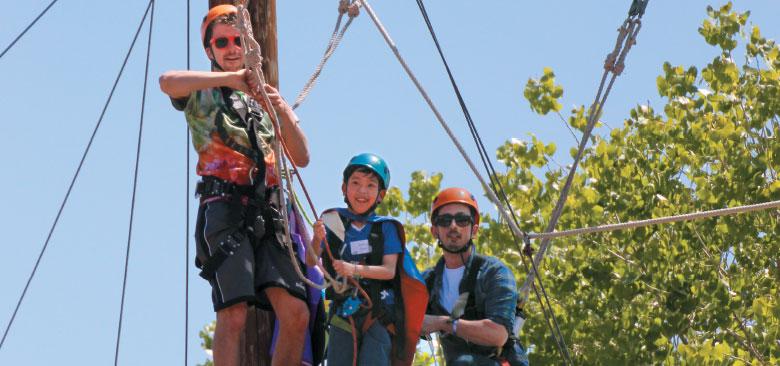
Kaedyn Quan prepares to zip-line.
Pulmonary Hypertension Camp Delivers a Chance to Breathe
Since his birth at 22.5 weeks, 10-year-old Kaedyn Quan and his family have undergone more health challenges than most families will experience in one or even three lifetimes.
The challenges include spending the first six months of his life in the hospital, multiple open heart surgeries, the resection of his left lung and a diagnosis of pulmonary hypertension (PH) – a rare, chronic and life-threatening disease in which dangerously high blood pressure in the lungs puts extra stress on the heart.
Most recently, with his remaining lung beginning to fail, Kaedyn and his mother were awaiting a lung transplant at Texas Children’s Hospital in Houston – they’d been there since June – when Hurricane Harvey hit the city. They survived the storm, but as of this writing are still waiting on the lung. Thankfully, an experience a few months earlier is helping to keep their spirits high: a four-day camp in Lake Hughes, Calif., solely for children with PH and their families.
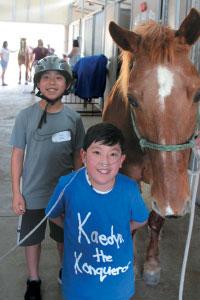 Kaedyn and his brother, Kyle There, for the first time in Kaedyn’s life, he and his family engaged in activities that are typically off-limits to kids with PH. Surrounded by caring, well-trained staff and 21 other families who had a child with PH, Kaedyn and his older brother, Kyle, did everything from archery and horseback riding to hurtling down a zip line from a 50-foot tower. Kaedyn’s zip-line adventure included a Superman cape and respiratory therapists on either end of the course, first unhooking Kaedyn’s oxygen and then hooking him back up at the end of his run.
Kaedyn and his brother, Kyle There, for the first time in Kaedyn’s life, he and his family engaged in activities that are typically off-limits to kids with PH. Surrounded by caring, well-trained staff and 21 other families who had a child with PH, Kaedyn and his older brother, Kyle, did everything from archery and horseback riding to hurtling down a zip line from a 50-foot tower. Kaedyn’s zip-line adventure included a Superman cape and respiratory therapists on either end of the course, first unhooking Kaedyn’s oxygen and then hooking him back up at the end of his run.
“He was a little nervous when he got to the top of the tower, but he put on his cape, and as soon as he came down, he was shouting, ‘Did you see me? Did you see me? I was awesome!’” laughs Claire Parker (MS ’11), a pediatric nurse practitioner (PNP) in the UCSF Pulmonary Hypertension Program who was the camp’s primary organizer. “Those kinds of reactions happened a lot that weekend.”
Bringing an Idea to Fruition
While research over the last 15 years, much of it originating at UCSF, has led to new treatment options and increased the five-year survival rate for pediatric PH from 40 percent to 80 percent, there is still no cure. Medication and oxygen are constant companions for most children with the disease and their families; they regularly face life-threatening challenges.
 “Having a kid with pulmonary hypertension is very different than it is for adults,” says UCSF critical care physician Jeffrey Fineman, a leading pediatric PH expert. Fineman had been mulling the idea of a camp for years, ever since he’d instituted family sessions at an international conference on pediatric PH that UCSF runs each year. “There aren’t a tremendous amount of resources for these families, and at these sessions, it’s been remarkable to watch them bond as they meet people going through similar things.”
“Having a kid with pulmonary hypertension is very different than it is for adults,” says UCSF critical care physician Jeffrey Fineman, a leading pediatric PH expert. Fineman had been mulling the idea of a camp for years, ever since he’d instituted family sessions at an international conference on pediatric PH that UCSF runs each year. “There aren’t a tremendous amount of resources for these families, and at these sessions, it’s been remarkable to watch them bond as they meet people going through similar things.”
When Parker – who had spent time volunteering in camps for children with cancer – joined UCSF’s pediatric PH team in 2016, Fineman mentioned his camp idea. From there, he says, “Claire really made the whole thing happen.”
Parker and her PNP colleague and PH service partner Elizabeth Colglazier (MS ’09) began making calls and quickly made two key contacts. One was the Painted Turtle camp, which specializes in creating programs for children with severe medical challenges.
The other was Nick and Kristin Chaset. After two open heart surgeries and a nearly yearlong stay at UCSF Benioff Children’s Hospital San Francisco, the Chaset’s 2-year-old daughter, Megan, is now at home but still receives ventilation and oxygen constantly through a tracheostomy tube and takes as many as 16 medications a day.
“UCSF saved Megan’s life multiple times…and we felt a strong need to give back,” Kristin says. “[So when] they came to us with this idea of camp, it was like a light switch.”
The Chasets put together an online auction and charity event, solicited other donations and raised more than $55,000, so that patients and their families, many of whom have limited means, could attend the camp for free. Once the funds were in place, Parker really went to work.
She and the Painted Turtle staff hashed out the details for how the camp would work, including Parker preparing both staff and volunteers for the unique medical challenges that kids with PH face. “When these kids get sick, they get really sick,” says Parker. “It can be very scary if you’re not familiar with it.” A host of volunteers from Stollery Children’s Hospital in Canada and UCSF – including Parker, Colglazier, Fineman, pediatric cardiologist and PH specialist Hythem Nawaytou, an intensive care physician, a medical resident, nurses and respiratory therapists – bolstered the support the children would have.
Parker also began enrolling families from California, Minnesota, Arizona and Stollery and coordinating their travel plans. “If people drove, we gave them gas cards. We also flew several families down by working with Angel Flight, which flies medically fragile patients for free,” she says.
Four Days of Fun and Education
Once everyone arrived, the fun could begin for the children with PH – most were between the ages of 6 and 17 – and their parents, siblings and other relatives.
“The kids went as far as their limitations would take them,” says Parker. “Kids with tracheostomies – and one with a ventricular assist device – went down the zip line. The camp also organized a group for older campers – the late night turtle crew – that helped one shy girl climb a 50-foot rock wall. She also sang and played guitar beautifully at the talent show.”
Siblings, who bear their own burdens, could meet others undergoing similar challenges and make new friends. Parents took advantage of educational seminars led by Parker and Fineman, which described things such as the latest research findings and available community resources.
“Over the years, I’ve thought about sending Kaedyn to [other camps], but when this came up, this family camp, it felt right and it was perfect timing,” says his mother, Stephanie So, who is a nurse in the cardiovascular intensive care unit at UCSF Benioff Children’s Hospital San Francisco. “He could do things he can’t do regularly, and for his brother to see other kids [like Kaedyn and the siblings of other kids with PH] and be around that – we could really feel the magical spirit of the camp embrace us.”
“As an ICU doctor, I am not known for being too emotional, but this was one of the most rewarding couple of days I’ve had as a physician,” says Fineman.
“From a provider perspective, to see kids outside of the hospital in a normal environment and vice versa builds a new kind of trust and friendship,” says Parker. “It was really wonderful to be part of a program and service that is looking beyond medicine to treat these kids with truly holistic care. It’s so important and so often forgotten.”
Keeping It Going
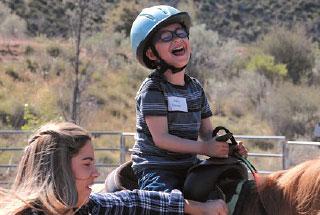 Edrey Now the task is keeping the camp going as an annual event and finding ways to maintain and grow the burgeoning community. That means raising between $40,000 and $50,000 each year. The Chaset family is again generously leading this year’s effort, with a fundraiser set for January 29, 2018, and a website with details on how to donate and a report on their camp experience. The dates for 2018 – March 23-26 – are already set.
Edrey Now the task is keeping the camp going as an annual event and finding ways to maintain and grow the burgeoning community. That means raising between $40,000 and $50,000 each year. The Chaset family is again generously leading this year’s effort, with a fundraiser set for January 29, 2018, and a website with details on how to donate and a report on their camp experience. The dates for 2018 – March 23-26 – are already set.
Nearly everyone involved believes it’s important to keep going because the powerful impact of just four days together remains. Consider Edrey, a younger participant who underwent a cardiac catheterization the day after camp.
“It’s a routine diagnostic procedure to look at pulmonary pressures, but when I visited him and his family in prep, they said Edrey had been asking all morning to remember the song we sang with the hand motions and the fire – he wanted it to help him with his procedure,” says Parker.
“I know that as a family, whenever we talk about it, we start smiling,” says So. “We remember the fun. Mention a few people’s names. Sing the songs and act them out, and rethinking that memory makes me feel good inside. I feel very grateful they put something like this together for us, and we’re hoping for another opportunity.”

